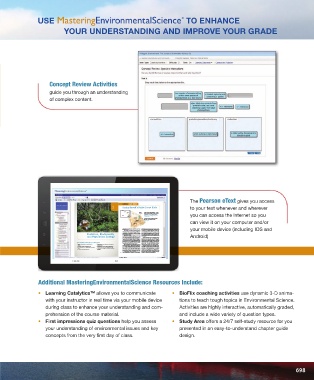Page 699 - Environment: The Science Behind the Stories
P. 699
usE to EnhancE
www.masteringenvironmentalscience.com
your undErstanding and improvE your gradE
Concept Review Activities
guide you through an understanding
of complex content.
The Pearson eText gives you access
CeNtRal CasE stUdy
3 saving Hawaii’s Native Forest Birds to your text whenever and wherever
KAUA`I
O`AHU
MAUI Hakalau “When an entire island avifauna . . . is dev-
Forest NWR
astated almost overnight because of human
meddling, it is, quite simply, a tragedy.”
Pacific you can access the Internet so you
Ocean — H. douglas Pratt, ornithologist and expert on
HAWAI`I
Hawaiian birds
Mauna Kea
Hilo “To keep every cog and wheel is the first
precaution of intelligent tinkering.”
HAWAI`I
—aldo Leopold can view it on your computer and/or
Mauna Loa
Jack Jeffrey stopped in his tracks. “I hear one!” he said. “Over mating preferences, diets, and bill shapes. Bills in some species your mobile device (including IOS and
there in those trees!” became short and straight, allowing birds to glean insects from
Native Hawaiian forest at Hakalau Forest NWR, and the endangered ‘akiapo¯la¯‘au Jeffrey quickly led his group of ecotourists through a leaf surfaces. In other species, bills became long and down-
misty woodland of ferns, grasses, koa trees, and red-flowering curved, enabling birds to probe into flowers to sip nectar. The
‘o¯ hi‘a-lehua trees toward an emphatic chirping sound that car- bills of still other species became thick and strong for cracking
Evolution, Biodiversity, ried farther than the other bird songs in the forest. At last they seeds. Some bills became highly specialized: The aki uses the
spotted the bird—an ‘akiapo¯la¯ ‘au, one of fewer than 1500 of
short, straight lower half of its bill to peck, woodpecker-style,
its kind left alive in the world.
into dead twigs and branches of koa trees to find beetle grubs,
and Population Ecology wonder of nature—one of many exquisite birds that evolved and then uses the long, downcurved upper half to reach in and Android)
The ‘akiapo¯ la¯ ‘au (or “aki” for short) is a sparrow-sized
extract the grubs.
on the Hawaiian Islands and exists only here. For millions of
Hawaii’s honeycreepers thrived for several million years in
years, this chain of islands in the middle of the Pacific Ocean the island’s forests, amid a unique community of plants. The
has acted as a cradle of evolution, generating an abundance stately ‘o¯ hi‘a, a slow-growing tree that can live for 2000 years,
of new and unique species. Yet in recent years, many of these spreads twisting gnarled limbs covered with moss and lichens
species have gone from cradle to grave. Half of Hawaii’s native through the misty air, and offers up bright red flowers that provide
bird species (70 of 140) have gone extinct in recent times, and
nectar and pollen to birds and insects. The koa thrives here too,
Upon completing this chapter, you will be able to: the percentage of species that teeter on the brink of extinction a fast-growing acacia tree with twigs that the aki snaps off in its
The aki is one of 30 species of endangered birds remaining
Explain natural selection and cite evidence for this Outline the characteristics of populations that help predict here today is higher than anywhere else in the world. search for grubs. A multitude of shrubs, herbs, and vines found
nowhere else in the world used to fill out the forest understory.
process population growth on the Hawaiian Islands. It is a type of Hawaiian honeycreeper, Today native Hawaiian forests are under siege. The cri-
Describe how evolution influences biodiversity Assess logistic growth, carrying capacity, limiting factors, a group of birds numbering 18 living species (and at least 38 sis began several hundred years ago when Polynesian settlers
species recently extinct), all of which originated from individu-
colonized the islands, cutting down trees and introducing non-
and other fundamental concepts in population ecology
Discuss reasons for species extinction and mass extinction als of a single ancestral species that reached Hawai‘i several native animals. Europeans arrived in the 1800s and did more
events Identify efforts and challenges involved in the conservation of million years ago. As new volcanic islands emerged from the of the same. Pigs, goats, and cattle ate their way through the
List the levels of ecological organization biodiversity ocean and then eroded away, and as forests expanded and native plants, transforming lush forests into ragged grasslands.
contracted over the millennia, populations were split many
Rats, cats, dogs, and mongooses destroyed the eggs and
times, and new honeycreeper species evolved. young of native ground-nesting birds. Foreign plants from Asia,
As honeycreeper species diverged from one another, they Europe, and America, whose seeds accompanied the people
48 evolved different colors, sizes, body shapes, feeding behaviors, and animals, spread across the altered landscape.
M03_WITH7428_05_SE_C03.indd 48 04/07/13 2:01 PM
M03_WITH7428_05_SE_C03.indd 47 04/07/13 2:01 PM
Additional MasteringEnvironmentalScience Resources Include:
• learning catalytics™ allows you to communicate • Bioflix coaching activities use dynamic 3-D anima-
with your instructor in real time via your mobile device tions to teach tough topics in Environmental Science.
during class to enhance your understanding and com- Activities are highly interactive, automatically graded,
prehension of the course material. and include a wide variety of question types.
• first impressions quiz questions help you assess • study area offers a 24/7 self-study resource for you
your understanding of environmental issues and key presented in an easy-to-understand chapter guide
concepts from the very first day of class. design.
698
WITH7428_05_WT_PRF.indd 7 12/07/13 2:40 PM

